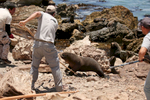Zoology: Saving Punta San Juan
For nearly a decade, Brookfield Zoo and its parent, the Chicago Zoological Society, have been sending researchers headed by veterinarian Dr. Michael Adkesson to Punta San Juan in Peru.
Called Peru's Galapagos by some, Punta San Juan is one of the world's richest marine ecosystems, a place that offers a staggering, rare concentration of species in a landscape of dry cliffs bordered by the Pacific Ocean. It's also a 133-acre coastal reserve that has become a central part of Dr. Adkesson's life and a crucial piece in the mission of the Chicago Zoological Society to spread conservation awareness internationally.
During the annual trips to Punta San Juan Dr. Adkesson and his team assess the health of fur seals, sea lions and a variety of seabirds and penguins. The institution also has broader goals of making Punta San Juan a model for 32 similar sites in Peru and, eventually, a global model for responsible marine wildlife management.














